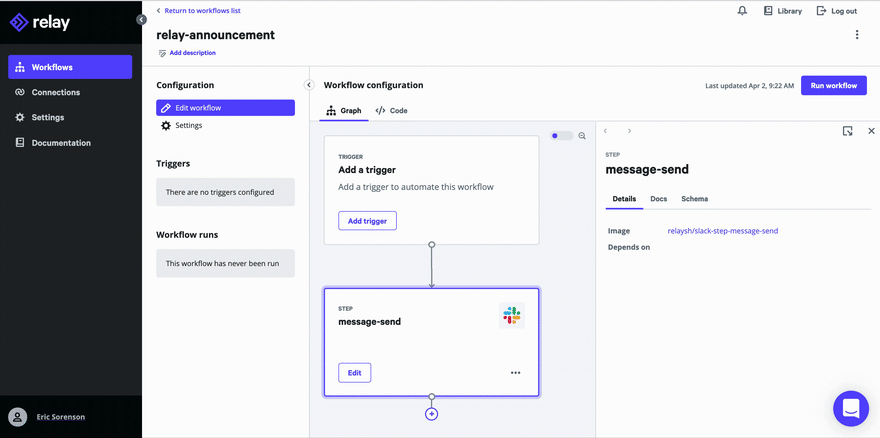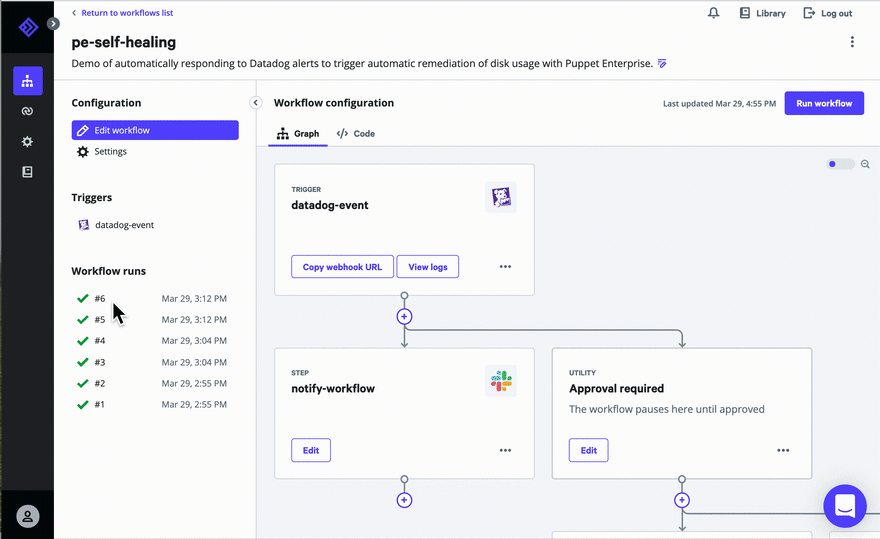Today we’re proud to announce the general availability of Relay, a cloud-native workflow automation platform. We launched our public beta of Relay last June, and we’re now officially out of beta and open for business! We’ve been pretty busy during the beta period - early users have executed thousands of workflows, processed tons of events, and given us incredibly helpful feedback.
We believe there is tremendous demand for a new kind of low-code, responsive automation product because:
- The cloud has radically changed how we build and operate systems.
- Lower-level infrastructure components are, for the most part, good enough at the problems they are intended to solve.
- Complexity has moved up the stack, beyond configuring operating systems and into how we tie services, APIs, and distributed systems together.
- DevOps teams encompass a wide range of skills, and it’s important to the business that their tiny number of automation specialists democratize their knowledge across the organization.
Thus, how we automate across our infrastructure must change accordingly.
We’ve heard over and over from our users how their quotidian tasks are deceptively tricky and involve sequencing lots of actions across all manner of different services. Going through these tasks manually introduces room for error, even when they’re properly documented. Between responding to service-down incidents, rolling back failed deployments, and securing cloud resources… the struggle is real.
Solving these problems involves gluing together a patchwork of existing scripts, bespoke in-house APIs, and 3rd-party services to get anything done. This emerging need for better orchestration is why Relay is built around event-driven workflows. What does that mean, exactly?
Modern service architectures generate all kinds of events — mostly noise, but with important signals intermixed — and the ability to understand and respond to those events automatically is key. YAML-based workflows provide a readable, reusable abstraction that the whole team can comprehend and iterate on. They’re well-suited for assembling individual automation “steps” into an end-to-end solution. So, combining workflows and events leads to truly responsive automation that can cover the full continuum of scenarios ops folks are regularly faced with, at the velocity they need.
Powerful abstractions like events and workflows are great, but not if they come at the expense of accessibility or if they present users with more of a learning cliff than a gentle curve. One thing we learned during the beta was that users wanted the best of both worlds: a simple workflow authoring experience that doesn’t require much coding, but that is also harmonious with their overall infrastructure-as-code approach. This is why Relay takes a low-code approach to workflow authoring. We’ve spent a lot of time making that experience quick and easy, but all the while changes are bi-directionally synced to human-friendly code.
It’s been wonderful seeing the automation problems that our users have solved with Relay. The major themes that have arisen are:
- Self-healing infrastructure - using Relay to add intelligence to existing automation tools, driving them in response to high-signal events, and integrating them into higher-level, auto-remediation workflows, e.g. combining Relay with Puppet Enterprise or doing automated rollback of a complex deployment.
- Compliance - using Relay to continually verify the security posture of key cloud resources by receiving infrastructure events and then applying the right compliance policies. This is such an important issue for users that we plan to do a lot more on this front. Stay tuned for more on this soon!
- Incident response - using Relay to enrich alert data, automate incident communications, and trigger auto-remediation workflows, e.g. our partnerships with PagerDuty, DataDog, and Splunk.
Case Study
One of our current customers, Bryxx NV, is a Belgium-based managed service provider that is consolidating its cloud automation stack onto Relay. Bryxx manages its customers’ multi-cloud infrastructure and collects telemetry in Grafana. We worked together to build a Grafana integration for Relay with two parts: Relay receives threshold alerts from Grafana when additional capacity is needed. After running workflows that handle the scale-up, Relay posts an annotation back into Grafana, so there’s a record of the workflow run overlaid on the dashboard, providing an audit trail and visual record of the changes.
Before using Relay, Bryxx had parts of these operations automated but still had to manually coordinate and orchestrate the changes. Now, Bryxx’s DevOps Architect Dries Dams says, “Relay helps us connect all the dots, achieving true self-healing systems on cloud-native platforms. The ease with which we can create new workflows saves us countless hours of developing custom scripts leaving more time for our engineers to help our customers grow their business.”
Next steps
The next step, and the best step, is to try it out (for free)! There are two additional tiers that complement the free Community tier:
- Team : ($20 user/month) For small to mid-sized teams, this tier provides access to up to 30 users, 500 active workflows, Role-Based Access Control (RBAC), and Single Sign-On (SSO).
- Enterprise : For large organizations with on-prem needs, this tier provides up to 5,000 active workflows and up to 5,000 users. It also provides RBAC and SSO and on-prem connectivity with Puppet Enterprise, Puppet’s flagship product. Contact sales for pricing.
If you’d like to learn more about Relay:
- How to get involved to extend Relay to better meet your needs and become part of the Relay community.
- The documentation site introduces Relay, its usage, core concepts, and extension points.
- Join the Puppet community Slack - come linger in the #relay channel! The more the merrier.
Thanks, and happy automating!





Top comments (0)